- PRESS RELEASE
ECB publishes supervisory banking statistics for the third quarter of 2022
11 January 2023
- Aggregate Common Equity Tier 1 ratio down to 14.74% in third quarter of 2022 (compared with 14.97% in previous quarter and 15.47% in same quarter of 2021)
- Aggregated annualised return on equity stable at 7.55% in third quarter of 2022 (compared with 7.59% in previous quarter and 7.19% in same quarter of 2021)
- Aggregate non-performing loans ratio (excluding cash balances) fell further to 2.29%, down from 2.35% in previous quarter, while loans showing significant increase in credit risk (stage 2 loans) continued to grow slightly, standing at 9.79% (up from 9.72% in previous quarter)
Capital adequacy
The aggregate capital ratios of significant institutions (i.e. those banks that are supervised directly by the ECB) decreased in the third quarter of 2022. The aggregate Common Equity Tier 1 (CET1) ratio stood at 14.74%, the aggregate Tier 1 ratio stood at 16.03% and the aggregate total capital ratio stood at 18.68%. Aggregate CET1 ratios at country level ranged from 12.48% in Spain to 24.06% in Estonia. Across Single Supervisory Mechanism business model categories, diversified lenders reported the lowest aggregate CET1 ratio (13.74%) and development/promotional lenders reported the highest (31.00%).
Chart 1
Capital ratios and their components by reference period
(EUR billions; percentages)
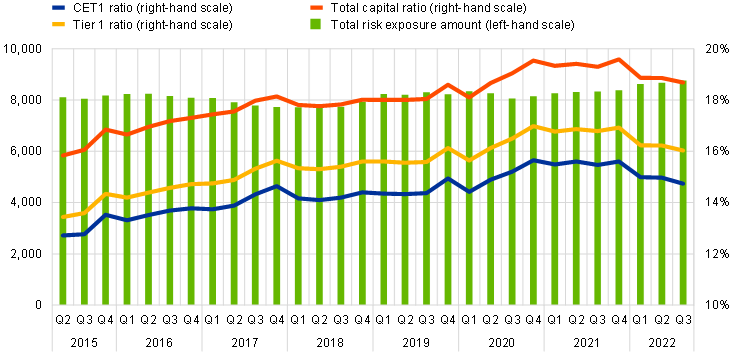
Source: ECB.
Chart 2
Capital ratios by home country for the third quarter of 2022
(percentages)
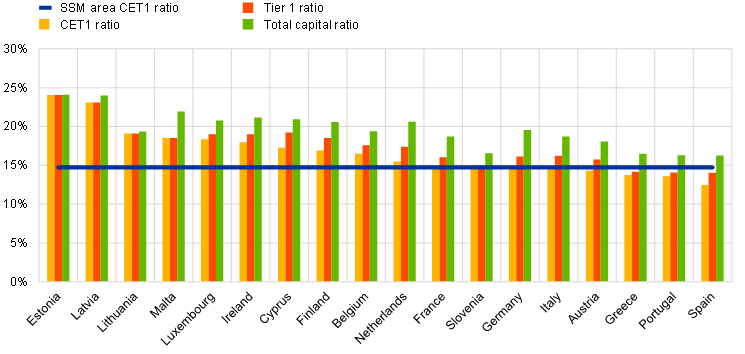
Source: ECB.
Note: Some countries participating in European banking supervision are not included in this chart, either for confidentiality reasons or because there are no significant institutions at the highest level of consolidation in that country.
Chart 3
Capital ratios by business model for the third quarter of 2022
(percentages)
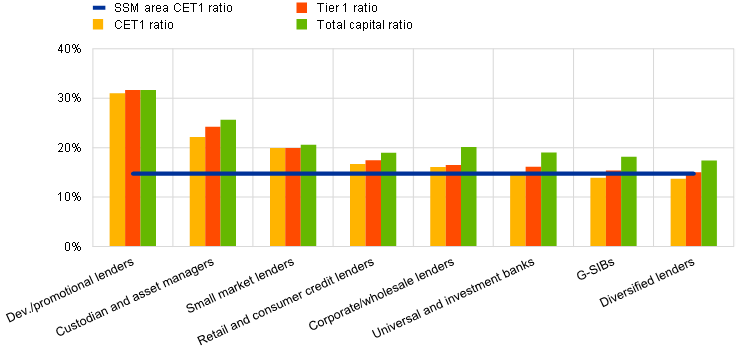
Source: ECB.
Notes: “G-SIBs” stands for global systemically important banks. “Dev./promotional lenders” stands for Development/promotional lenders.
Asset quality
The non-performing loans (NPL) ratio excluding cash balances at central banks and other demand deposits decreased to 2.29% in the third quarter of 2022. The decrease was driven by a further reduction in the stock of NPLs to €348 billion (compared with €351 billion in the previous quarter) as well as an increase in total loans and advances (excluding cash balances) to €15,201 billion (compared with €14,962 billion in the previous quarter).
At country level, the average NPL ratio excluding cash balances (green bars on Chart 5) ranged from 0.85% in Estonia to 7.50% in Cyprus. Across business model categories, custodians and asset managers reported the lowest aggregate NPL ratio excluding cash balances (0.62%) and diversified lenders reported the highest (3.40%).
Aggregate stage 2 loans as a share of total loans continued to increase slightly in the third quarter of 2022, reaching 9.79% (up from 9.72% in the previous quarter). The stock of stage 2 loans amounted to €1,434 billion (compared with €1,399 billion in the previous quarter).
Cost of risk stood at an aggregate level of 0.48% in the third quarter of 2022 (down from 0.52% in the previous quarter). Across significant institutions, the interquartile range narrowed further to 0.52 percentage points (down from 0.56 percentage points in the previous quarter).
Chart 4
Non-performing loans by reference period
(EUR billions; percentages)
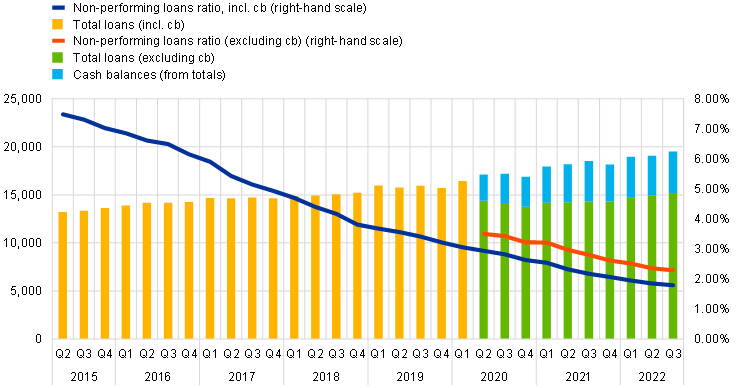
Source: ECB.
Note: “cb” stands for cash balances at central banks and other demand deposits.
Chart 5
Non-performing loans ratio by home country for the third quarter of 2022
(percentages)
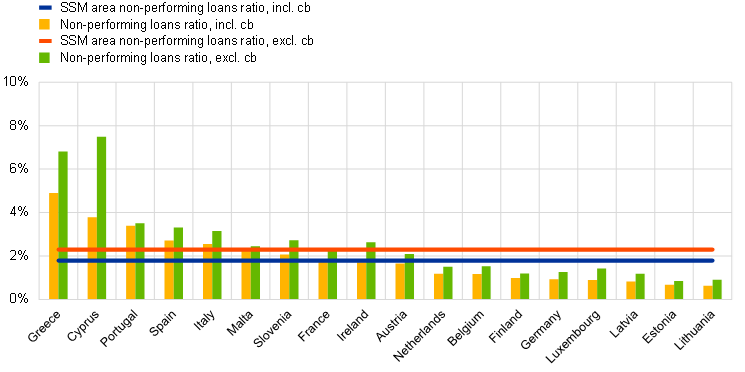
Source: ECB.
Notes: Some countries participating in European banking supervision are not included in this chart, either for confidentiality reasons or because there are no significant institutions at the highest level of consolidation in that country. “cb” stands for cash balances at central banks and other demand deposits.
Chart 6
Non-performing loans ratio by business model for the third quarter of 2022
(percentages)
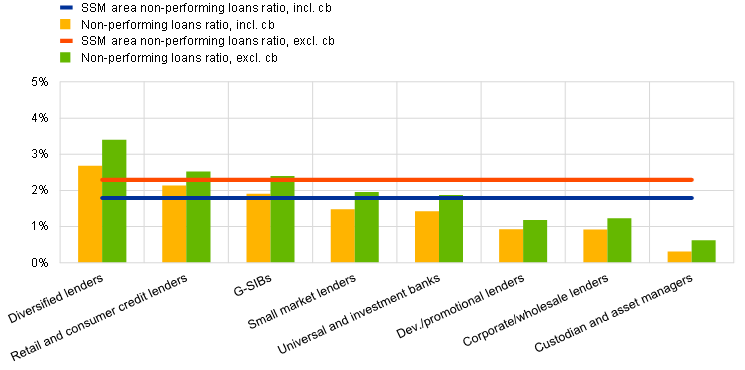
Source: ECB.
Note: “G-SIBs” stands for global systemically important banks. “Dev./promotional lenders” stands for Development/promotional lenders. “cb” stands for cash balances at central banks and other demand deposits.
Chart 7
Loans and advances subject to impairment review by reference period
(EUR billions; percentages)
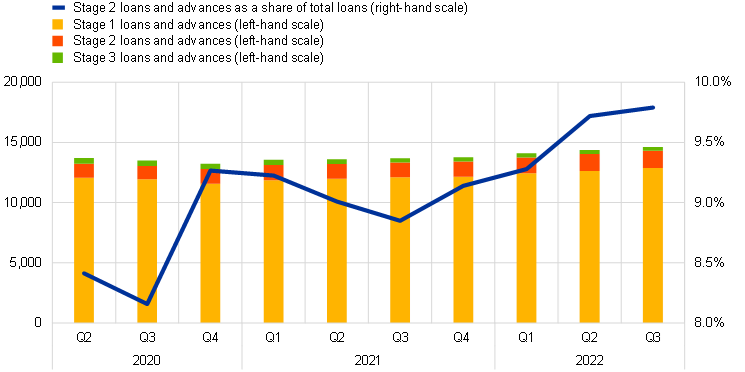
Source: ECB.
Note: Stage 1 includes assets where credit risk has not increased significantly since initial recognition, Stage 2 includes assets that have had a significant increase in credit risk since initial recognition, while Stage 3 includes assets that have objective evidence of impairment at the reporting date.
Chart 8
Cost of risk by reference period
(percentages)
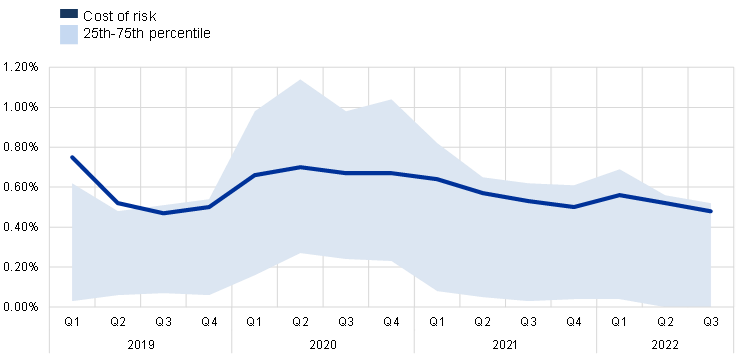
Source: ECB.
Return on equity
The aggregated annualised return on equity was stable at 7.55% in the third quarter of 2022 (compared with 7.59% in the previous quarter). Higher net interest income was a key profitability driver compared with both the previous quarter (increase of €2.5 billion) and with the same quarter of 2021 (increase of €17.9 billion).
Significant institutions from Slovenia showed the highest aggregated annualised return on equity in the third quarter of 2022 (18.80%) while significant institutions from Malta showed the lowest (-1.36%). Across Single Supervisory Mechanism business model categories, the aggregate annualised return on equity ranged from 9.97% for small market lenders to 2.84% for corporate/wholesale lenders.
Chart 9
Return on equity and composition of net profit and loss by reference period
(EUR billions; percentages)
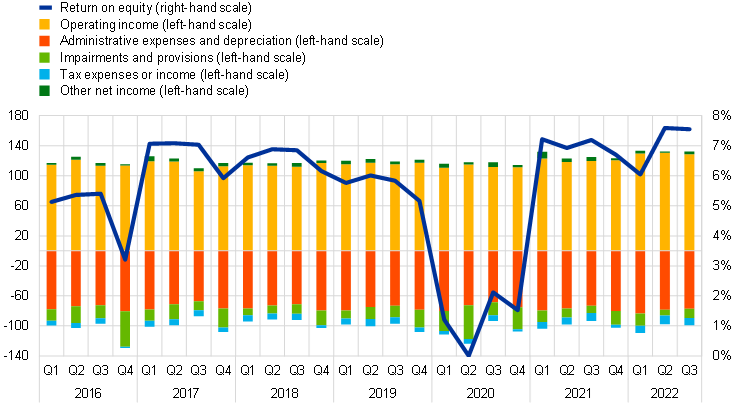
Source: ECB.
Chart 10
Return on equity by home country for the third quarter of 2022
(percentages)
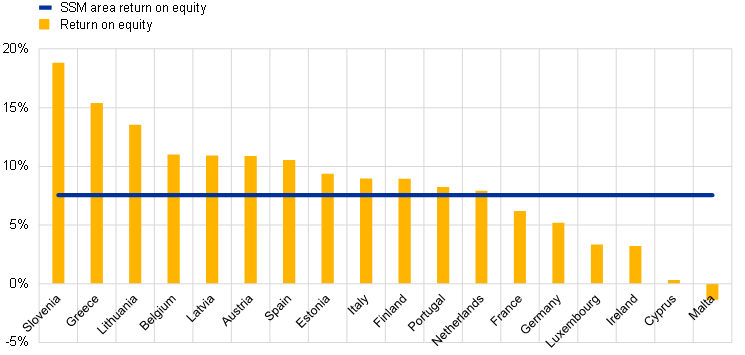
Source: ECB.
Chart 11
Return on equity by business model for the third quarter of 2022
(percentages)
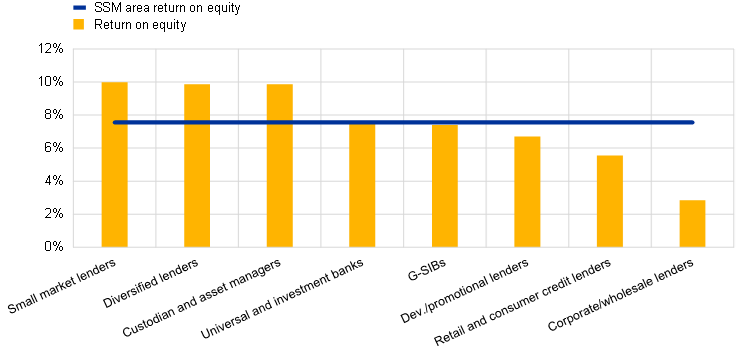
Source: ECB.
Note: “G-SIBs” stands for global systemically important banks. “Dev./promotional lenders” stands for Development/promotional lenders.
Liquidity and funding
The aggregate liquidity coverage ratio stood at 162.03% in the third quarter of 2022, down from 164.38% in the previous quarter. Both the liquidity buffer and the net liquidity outflow increased compared with the previous quarter (by €160 billion and €144 billion respectively).
Chart 12
Liquidity coverage ratio and its components by reference period
(EUR billions; percentages)
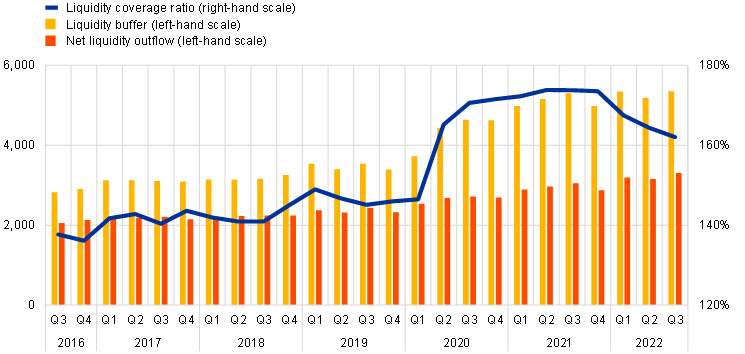
Source: ECB.
Loans and advances subject to COVID-19-related measures
In the third quarter of 2022 total non-expired loans and advances subject to COVID-19-related measures decreased further to €388 billion, down from €409 billion in the previous quarter. The decrease was driven by newly originated loans and advances subject to public guarantee schemes, which declined to €345 billion from €360 billion in the previous quarter.
Chart 13
Loans and advances subject to COVID-19-related measures by reference period
(EUR billions)
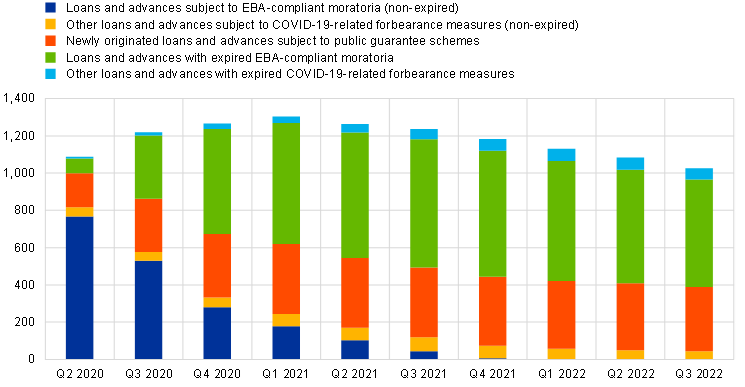
Source: ECB.
Note: “EBA” stands for European Banking Authority.
Factors affecting changes
Supervisory banking statistics are calculated by aggregating the data that are reported by banks which report COREP (capital adequacy information) and FINREP (financial information) at the relevant point in time. Consequently, changes from one quarter to the next can be influenced by the following factors:
- changes in the sample of reporting institutions;
- mergers and acquisitions;
- reclassifications (e.g. portfolio shifts as a result of certain assets being reclassified from one accounting portfolio to another).
For media queries, please contact Philippe Rispal, tel.: +49 69 1344 5482.
Notes
- The complete set of Supervisory banking statistics with additional quantitative risk indicators is available on the ECB’s banking supervision website.
European Central Bank
Directorate General Communications
- Sonnemannstrasse 20
- 60314 Frankfurt am Main, Germany
- +49 69 1344 7455
- media@ecb.europa.eu
Reproduction is permitted provided that the source is acknowledged.
Media contacts

